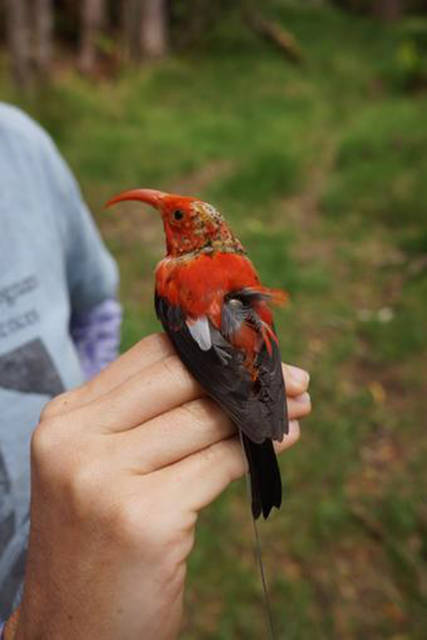Rare honeycreepers fighting decline
HILO — The migration patterns of one of Hawaii Island’s most iconic birds are likely contributing to its decline, according to a new study released last week.
The study, published in the journal Ecological Monographs, also analyzes different conservation measures that could be taken to best protect the native i‘iwi, a type of honeycreeper.
The i‘iwi, with its brilliant red plumage and long curved bill, is a “spectacular bird,” said U.S. Geological Survey researcher Eben Paxton, one of the study’s co-authors. “It’s sort of the poster child for the honeycreepers. It’s a bird that naturalists have always talked about.”
Alban Guillaument of the Hawaii Cooperative Studies Unit at the University of Hawaii at Hilo, Wendy Kuntz of Kapiolani Community College and Michael Samuel of the USGS Wisconsin Cooperative Wildlife Research Unit also contributed to the study.
As with most of Hawaii’s native birds, the i‘iwi population is threatened by a number of factors, including habitat loss and invasive species. The study focuses on disease, particularly avian malaria, which is carried by the Culex quinquefasciatus mosquito.
I‘iwi have “almost 100 percent mortality if they get bitten by a mosquito,” Paxton said. Because of global warming, the tropical mosquitoes are able to move into higher elevations, where forest birds have typically found refuge from disease.
Some birds, such as the akepa, Hawaii creeper and akiapolaau, spent all of their time above the “disease line” and are not as affected by avian malaria. But i‘iwi migrate to lower elevations to feed on nectar as trees and flowers bloom seasonally.
The study tracked these migration habits and combined them with a disease model created by Samuel to estimate what disease rates would be by 2100.
“We had these different pieces of information,” Paxton said. “(The study) allowed us to put it all together and look at the big picture … to say, ‘OK, this is how it’s going to affect the species in the future — should we be concerned, and if so, what do we do about it?’”
The results for disease rate were not encouraging, predicting that the bird could be extinct by 2100 if mitigation efforts were not made.
At last population count, in 2013, there were about 500,000 i‘iwi in Hawaii. Historically, they were found on all islands, but today about 90 percent of the population live on Hawaii Island. There has been a push to list i‘iwi as a threatened species.
Hakalau Forest National Wildlife Refuge, where birds were banded for tracking, is a stronghold for i‘iwi in part because of its cooler temperatures. Wildlife managers also worked to keep pigs out of the refuge: When pigs root in the ground and knock over ferns, they create mosquito breeding habitat.
“Just having some sort of restored, healthy forest seems to be making (birds) a little resilient,” Paxton said. “There’s more control of mosquitoes within the boundaries.”
“But again, one of the things that’s unique about i‘iwi is they’re moving outside of the refuge.”
The study also looks at ways to help stave off extinction. Habitat restoration also could include planting more flowering trees at higher elevations or providing nectar at hummingbird feeders for birds so they are less likely to leave in search of food.
Researchers investigated the possibility of the birds becoming more resistant to the disease over time and translocating malaria-resistant i‘iwi from other islands to bolster the population.
Reducing overall disease transmission would be the best course, Paxton said, but that likely would involve near-complete eradication of mosquitoes.
This possibility is closer now than it was when the four co-authors first began their work, in large part thanks to a recent research collaboration between the University of Hawaii, the U.S. Fish and Wildlife Service and the state Department of Land and Natural Resources. The research seeks to take advantage of a mosquito-bacteria relationship that causes mosquitoes to produce infertile young.
“Since we did this modeling, there’s been a real push toward more efforts to control mosquitoes in Hawaii, and maybe even eliminate them,” Paxton said. “Before, what we were considering for mosquito control was a lot of labor-intensive work to get rid of the larval habitat — stuff that’s really difficult to do across the whole landscape.”
Email Ivy Ashe at iashe@hawaiitribune-herald.com.


